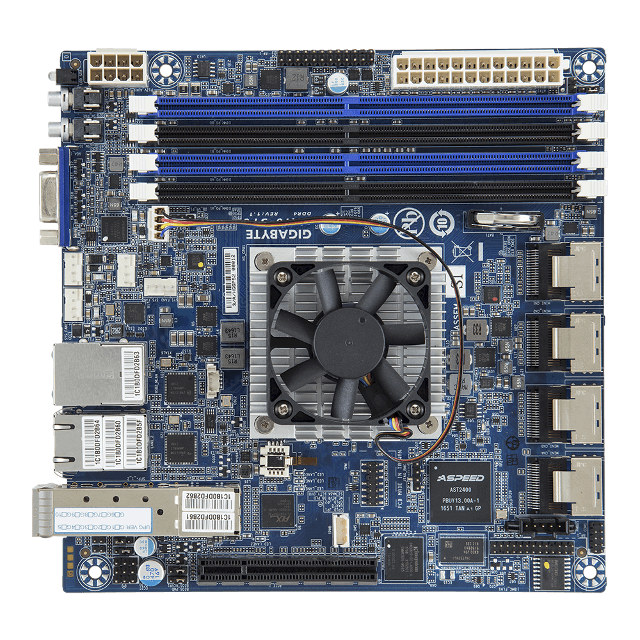Last year, we wrote about Intel Atom C3000 series processor for micro-servers with the post also including some details about MA10-ST0 motherboard. GIGABYTE has finally launched the mini-ITX board with an unannounced Atom C3958 16-core Denverton processor.

GIGABYTE MA10-ST0 server board specifications:
- Processor – Intel Atom C3958 16-core processor @ up to 2.0GHz with 16MB L2 cache (31W TDP)
- System Memory – 4x DDR4 slots for dual channels memory @ 1866/2133/2400 MHz with up to 128GB ECC R-DIMM, up to 64GB for ECC/non-ECC UDIMM
- Storage
- 32GB eMMC flash
- 4x Mini-SAS up to 16 x SATA 6Gb/s ports
- 2x Mini-SAS ports are shared with PCIe x8 slot
- Connectivity
- 2x 10Gb/s SFP+ LAN ports
- 2x 1Gb/s LAN ports (Intel I210-AT)
- 1x 10/100/1000 management LAN
- Video – VGA port up to 1920×1200@60Hz 32bpp; Aspeed AST2400 chipset with 2D Video Graphic Adapter with PCIe bus interface
- USB – 2x USB 2.0 ports
- Expansion Slots – 1x PCIe x8 (Gen3 x8 bus) slot; shared with Mini-SAS ports, Mini_CN2, Mini_CM3
- Misc
- 1x CPU fan header, 4x system fan headers
- 1x TPM header with LPC interface
- 1x Front panel header
- 1x HDD back plane board header
- 1x JTAG BMC header
- 1x Clear CMOS jumper
- 1x IPMB connector
- 1x PMBus connector
- 1x COM (RS-232)
- Power and ID buttons with LEDs; status LED
- Board Management – Aspeed AST2400 management controller; Avocent MergePoint IPMI 2.0 web interface
- Power Supply – 1x 24-pin ATX main power connector; 1x 8-pin ATX 12V power connector
- Dimensions – 170 x 170 mm (Mini-ITX form factor)
- Temperature Range – 10 to 40°C
- Relative Humidity – 8-80% (non-condensing)
The dual core Atom C3338 is the only processor listed on Intel’s formerly Denverton page, with now info about the 16-core Atom C3958 processor so far.

The board is said to support Windows Server 2016, Red Hat Enterprise Linux Server 7.1, SuSE Linux Enterprise Server 12, Ubuntu 14.04.2 LTS, Fedora 22, and CentOS 7.1. The board is sold with an I/O shield and a quick start guide. There’s no word about pricing or availability on the product page, but Anandtech reports that the “board is essentially ready to go, and interested parties should get in contact with their local reps”. For reference, SuperMicro A2SDI-H-TP4F-O board based on the same processor is sold for $820+ on Atacom.

Jean-Luc started CNX Software in 2010 as a part-time endeavor, before quitting his job as a software engineering manager, and starting to write daily news, and reviews full time later in 2011.
Support CNX Software! Donate via cryptocurrencies, become a Patron on Patreon, or purchase goods on Amazon or Aliexpress




